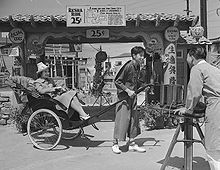Chinatown, Los Angeles
Chinatown | |
|---|---|
Neighborhood of Los Angeles | |
 Chinatown Gateway Monument, marking the entrance to Los Angeles' Chinatown | |
 Map of the Chinatown neighborhood of Los Angeles, as delineated by the Los Angeles Times | |
 Chinatown Location within Downtown Los Angeles | |
| Coordinates: 34°03′46″N 118°14′16″W / 34.062888°N 118.23789°W | |
| Elevation | 94 m (308 ft) |
| Time zone | UTC-8 (PST) |
| • Summer (DST) | UTC-7 (PDT) |
| Zip codes | 90012 |
| Area code(s) | 213, 323 |
Chinatown is a neighborhood in Downtown Los Angeles, California that became a commercial center for Chinese and other Asian businesses in Central Los Angeles in 1938. The area includes restaurants, shops and art galleries but also has a residential neighborhood with a low-income, aging population of about 20,000 residents.
The original Chinatown developed in the late 19th century, but it was demolished to make room for Union Station, the city's major ground-transportation center.[2][3][4] A separate commercial center, known as "New Chinatown," opened for business in 1938.
Geography and climate[]
According to CRA/LA, borders of (the current) Chinatown neighborhood are:[5][6][7]
- on the north: Stadium Way and Dodger Stadium/Chavez Ravine, which the L.A. Times includes as part of the Elysian Park neighborhood;
- in addition, there is a northern sliver along North Broadway between Radio Hill Gardens on the northwest and Los Angeles State Historic Park on the southeast
- to the west and northwest, Beaudry and Figueroa streets and the greater Echo Park neighborhood
- on the east,
- according to CRA/LA: North Main Street, Los Angeles State Historic Park and industrial areas along the west bank of the Los Angeles River
- according to the L.A. Times: the Los Angeles River and Lincoln Heights neighborhood
- on the south, Cesar Chavez Avenue and the Civic Center and Los Angeles Plaza historic districts of Downtown Los Angeles
| hideClimate data for Chinatown, Los Angeles | |||||||||||||
|---|---|---|---|---|---|---|---|---|---|---|---|---|---|
| Month | Jan | Feb | Mar | Apr | May | Jun | Jul | Aug | Sep | Oct | Nov | Dec | Year |
| Average high °F (°C) | 68 (20) |
70 (21) |
70 (21) |
74 (23) |
75 (24) |
80 (27) |
85 (29) |
86 (30) |
84 (29) |
80 (27) |
73 (23) |
69 (21) |
76 (24) |
| Average low °F (°C) | 47 (8) |
49 (9) |
51 (11) |
53 (12) |
57 (14) |
61 (16) |
64 (18) |
65 (18) |
64 (18) |
59 (15) |
51 (11) |
47 (8) |
56 (13) |
| Average precipitation inches (mm) | 3.47 (88) |
3.81 (97) |
3.24 (82) |
0.85 (22) |
0.31 (7.9) |
0.07 (1.8) |
0.02 (0.51) |
0.14 (3.6) |
0.35 (8.9) |
0.39 (9.9) |
1.16 (29) |
1.98 (50) |
15.80 (401) |
| Source: [8] | |||||||||||||
History[]
Chinatown can refer to one of three locations near downtown Los Angeles. What is now known as Old Chinatown refers to the original location on Alameda and Macy (1880s–1933). Old Chinatown was displaced by the construction of Union Station, and two competing Chinatowns were built in the late 1930s north of Old Chinatown to replace it: China City (1938–1948) and New Chinatown (1938–present). China City was rebuilt just one year after opening due to a suspicious fire, but another fire in 1948 put it out of business for good.
Old Chinatown[]
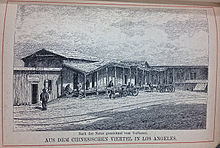
In the early 1860s, thousands of Chinese men, most of them originating from Guangdong province in southern China, were hired by Central Pacific Railroad Co. to work on the western portion of the first transcontinental railroad. Many of them settled in Los Angeles.[9]
In the Chinese massacre of 1871, 19 Chinese men and boys were killed by a mob of about 500 men in an area of Los Angeles known as Calle de los Negros or Negro Alley, which had been known as a dangerous area for two decades. It was one of the most serious incidents of racial violence that has ever occurred in the American West.[10]
The first Chinatown, centered on Alameda and Macy Streets (now Cesar Chavez Avenue), was established in 1880.[11] Reaching its heyday from 1890 to 1910, Chinatown grew to approximately fifteen streets and alleys containing some two hundred buildings. It boasted a Chinese Opera theater, three temples, a newspaper and a telephone exchange. But laws prohibiting most Chinese from citizenship and property ownership, as well as legislation curtailing immigration, inhibited future growth.[12]
From the early 1910s, Chinatown began to decline. Symptoms of a corrupt Los Angeles discolored the public's view of Chinatown; gambling houses, opium dens and a fierce tong warfare severely reduced business in the area. As tenants and lessees rather than outright owners, the residents of Old Chinatown were threatened with impending redevelopment, and as a result the owners neglected upkeep of their buildings.[3] Eventually, the entire area was sold and then resold, as entrepreneurs and developers fought over the area. After thirty years of decay, a Supreme Court ruling approved condemnation of the area to allow for construction of a major rail terminal, Union Station.[3][13] Residents were evicted to make room for Union Station without a plan for the relocation of the Chinatown community.
Chinatown was gradually demolished, leaving many businesses without a place to do business and forcing some to close. A remnant of Old Chinatown persisted into the early 1950s, situated between Union Station and the Old Plaza. Several businesses and a Buddhist temple lined Ferguson Alley, a narrow one-block street running between the Plaza and Alameda.[14] The most notable of the surviving buildings was the old Lugo Adobe, having been built in 1838 by the prominent Californio family. Some decades later, the Lugo Adobe became the original home of Loyola Marymount University, and later, it was rented to Chinese-Americans who ran shops on the ground floor and a lodging house upstairs. Christine Sterling, who had brought to fruition the Olvera Street and China City projects, argued that remaining buildings of Old Chinatown were an eyesore and advocated successfully for the razing of all the remaining structures between the Plaza and Union Station.[14]
- Points of interest
- Transit
- Parks
- Medical
"The original Chinatown's only remaining edifice is the two-story Garnier Building, once a residence and meeting place for immigrant Chinese," according to Angels Walk – Union Station/El Pueblo/Little Tokyo/Civic Center guide book. The Chinese American Museum is now situated in the Garnier Building.[3]
Seven years passed before an acceptable relocation proposal was put into place, situating a new Chinatown in its present location.[3]
In the late 1950s the covenants on the use and ownership of property were removed, allowing Chinese Americans to live in other neighborhoods and gain access to new types of employment.[15]
China City[]
Christine Sterling, who worked on the conversion of a neglected street into the Mexican-themed Olvera Street, conceived of a similar plan for the displaced Chinese American population.[14] On June 6, 1938, she opened China City,[16][17] a walled enclave bounded by Main, Ord, Spring, and Macy (now Cesar Chavez),[18]:37 featuring Chinese-style architecture, restaurants, shops, rickshaw rides, a lotus pond, and a temple. Costumed workers greeted tourists, and a Chinese opera troupe performed live shows in front of the shops.
Some replica buildings in China City came from the set of the 1937 Hollywood blockbuster, The Good Earth. A dragon decoration was salvaged from the Los Angeles Times building. The architect was William Tuntke, and construction was supervised by Tom Kemp, from Paramount Studios.[19] Gilbert Leong, who later was a prominent local architect, sculpted the statue of Kwan Yin that was set in a fountain for China City.[18]:59 [20]
China City received mixed support from Chinese American residents and businessmen. Many welcomed the economic opportunity the project provided. Others preferred the New Chinatown project, considered less distorted by the stereotyping lens of Hollywood.[21] During its eleven-year existence, China City was destroyed by fire and rebuilt numerous times. One fire destroyed approximately 1⁄4 of China City in February 1939.[22] In 1949, an act of arson destroyed China City, and the remainder was razed in 1955.[23]
Little Italy[]
The neighborhood that has become Chinatown was formerly Sonoratown and then Little Italy. In the early 20th century, Italian immigrants settled in the area north of the Old Plaza. Many built businesses, including wineries (San Antonio Winery is still in existence).[24] The Italian American Museum of Los Angeles in the El Pueblo de Los Ángeles Historical Monument opened in 2016.
New Chinatown[]
In the 1930s, under the efforts of Chinese-American community leader , the design and operational concepts for a New Chinatown evolved through a collective community process, resulting in a blend of Chinese and American architecture.[25] The Los Angeles Chinatown saw major development, especially as a tourist attraction, throughout the 1930s, with the development of the "Central Plaza,"[26] a Hollywoodized version of Shanghai, containing names such as Bamboo Lane, Gin Ling Way and Chung King Road (named after the city of Chongqing in mainland China). Chinatown was designed by Hollywood film set designers, and a "Chinese" movie prop was subsequently donated by film director Cecil B. DeMille to give Chinatown an exotic atmosphere.[27]
- Central Plaza

The dragon mural painted by Tyrus Wong and restored by Fu Ding Cheng (1984)
New Chinatown main plaza - Dec 2011
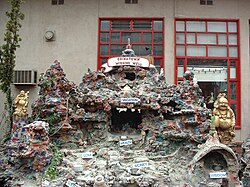
Wishing Well, 2001
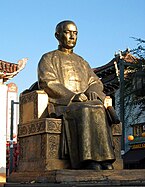
Statue of Sun Yat-sen
The Hop Sing Tong Society is situated in Central Plaza, as are several other Chinatown lodges and guilds. Near Broadway, Central Plaza contains a statue honoring Dr. Sun Yat-sen, the Chinese revolutionary leader who is considered the "founder of modern China". It was erected in the 1960s by the Chinese Consolidated Benevolent Association. A 7-foot tall statue of martial artist Bruce Lee was unveiled at Central Plaza on June 15, 2013.[28][29]

During the 1980s, many buildings were constructed for new shopping centers and mini-malls, especially along Broadway. Metro Plaza Hotel was opened in the southwest corner of Chinatown in the early 1990s. A large Chinese gateway is found at the intersection of Broadway and Cesar Chavez Avenue, funded by the local Teochew-speaking population.[30][31]

New Chinatown is served by the L Line of the city's Metro Rail; parts of Old Chinatown were uncovered during excavation for another portion of the L.A. subway (the Red Line connection to Union Station). The Metro Rail station in Chinatown has been described as a spectacular pagoda-themed facility and as a cliché of neo-pagoda architecture by Christopher Hawthorne, the Los Angeles Times architecture critic.[32][33][34]
In 1996, Academy Award-winning (for The Killing Fields in 1985) Cambodian refugee, physician and actor, Haing S. Ngor, was killed in the Chinatown residential area in a bungled robbery attempt by members of an Asian gang. It had been speculated that he was assassinated for his activism against the Khmer Rouge government of Cambodia, but this idea was later proved unfounded.[35]
By 2000 many people had left the Chinatown for the City of Monterey Park, which has a Chinese community in the San Gabriel Valley. In 2000 AsianWeek said that the Los Angeles Chinatown was "troubled."[36]
On June 28, 2008, a celebration of the 1938 founding of New Chinatown was held with the L.A. Chinatown 70th Anniversary Party.[37] "Though lacking the hustle and bustle of San Francisco's Chinatown, Los Angeles' version has charms of its own."[38]
Revitalization with new development[]
The 2010s and 2020s have seen the completion of several large mixed-use and multifamily residential buildings like other neighborhoods in and around Downtown Los Angeles.[39] Activists and city council members were concerned about rising rents and displacement of long time residents, many of them low-income as these revitalization projects were approved.[40] City officials and housing activists have debated how much affordable housing should be included amidst the market rate apartments and condominiums.[41]
Demographics[]
The 2010 U.S. census counted 20,913 residents in the 0.91-square-mile Chinatown neighborhood, excluding the population of the Los Angeles County Jail complex. That made an average of 9,650 people per square mile, which included the empty Cornfield area.[42]
The ethnic breakdown in 2010: Asian, 68.8%; Latino, 14.7%; blacks, 6.7%; whites, 8.7%; mixed race, 0.8%; and others, 2.3%.[43]
The median household income in 2010 dollars ($29,000), was the third-lowest in Los Angeles County, preceded by Watts ($28,200) and Downtown ($24,300). The percentage of households earning $20,000 or less (53.6%) was the third-largest in Los Angeles County, preceded by Downtown (57.4%) and University Park (56.6%). The average household size of 2.8 people was just about the city norm. Renters occupied 91% of the housing units, and home- or apartment owners the rest.[42]
Education[]


Just 11.7% of Chinatown residents aged 25 and older possessed a four-year degree in 2010, the sixth-least in Los Angeles County.[42]
Schools[]
There are three schools operating within Chinatown. They are:[44]
- Endeavor College Preparatory Charter School, middle, 126 Bloom Street
- Castelar Street Elementary School, LAUSD, 840 Yale Street
- Cathedral High School, a private Catholic boys' school, just down the hill from Dodger Stadium, is located on the north side of Chinatown. [5]
- - largest stand-alone ESL adult school in the nation[45]
Library[]
Los Angeles Public Library operates the Chinatown Branch.
Businesses[]
Retail[]
Small, specialized grocery stores are important to the aging population but few remain as gentrification impacts the neighborhood.[46] The Chinese-Vietnamese residents own many bazaars. The stores sell products such as soap, toys, clothes, music CDs at low prices. Several restaurants in Chinatown serve mainly Cantonese cuisine but there are also various Asian cuisine restaurants such as Teochew Chinese, Vietnamese, Indonesian, and Thai, which reflects the diverse character of Chinatown. Few boba cafes have opened in Chinatown, but a large number are to be found in the Chinese enclaves in the San Gabriel Valley.
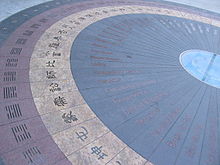
TS Emporium and Tin Bo are stores selling ginseng and herbs as well as other household merchandises are operated within the confinement of this particular Chinatown.
Dynasty Center, Saigon Plaza, and the Chinatown Phuoc Loc Tho Center feature many Vietnamese-style bazaars with people engaged in bargain shopping for items such as clothing, toys, Chinese-language CDs, pets, household items, funerary products, and so on. Its entrepreneurs are ethnic Chinese from Vietnam.
There are over 20 art galleries to see, mostly featuring non-Chinese modern art, with works from up and coming artists in all types of media.[26] Popular galleries include Acuna-Hansen Gallery, Black Dragon Society, China Art Objects, Jancar Gallery and The Gallery at General Lee's. Spaces such as Telic Art Exchange, Betalevel and The Mountain Bar often have readings, performances and lectures.
Restaurants[]
Chinatown is in the process of becoming an entirely new place. Chinatown at the height of popularity was filled with bustling Chinese restaurants that included barbecue delicatessens with glass displays of roast duck and suckling pig and Cantonese seafood restaurants with dim sum.[47][48][49] As the action in Chinese cuisine became centered in the San Gabriel Valley, southeast Asian eating places filled some of the empty spaces and offered Vietnamese pho noodle soup and submarine sandwiches called banh mi.[50] As downtown revives, Chinatown has been sparked into life by cheap rents, the gallery boom in the 2000s and deep-rooted sense of community.[51] Chinese bakeries and other shops continue to serve the area.[52] Traditional Chinese restaurants that have remained are being joined by a variety of new restaurants as the opportunities Chinatown offers is recognized by additional restaurateurs.[53] The area is better served by transit than many areas with Union Station so close by. Even though low-income seniors remain, college graduates can find their first apartment here and condos are becoming available for the affluent. This economic diversity encourages a diversity of places to serve the area.[52]
Two of Chinatown's restaurants highlight the history and diversity of this neighborhood.[54]
- Philippe's has been located on the corner of Alameda Street, at the edge of Chinatown, in the Historical District of Los Angeles since 1951,[55] and is known as one of the creators of the French Dip sandwich.[55]
- Little Joe's Italian American Restaurant, demolished in January 2014, had long stood at the corner of Broadway and College Street. It closed in December 1998 due to the expense of retrofitting the building to meet earthquake standards.[56] The interior was left unchanged and it has been used as a filming location.[57]
Recreation and parks[]

- Los Angeles State Historic Park, also known as the Cornfield,[58] consists of a long open space between Spring Street and the tracks of the Metro L Line.
- Alpine Recreation Center, at 817 Yale Street, has a combined and multipurpose room with a capacity of 250. Two indoor gymnasiums have capacities of 450 each. There are also basketball courts (lighted/indoor/outdoor), a children's play area and volleyball courts (lighted).[59]
Nomenclature[]

The words Los Angeles Chinatown are written and pronounced as follows as (traditional Chinese: 洛杉磯唐人街; simplified Chinese: 洛杉矶唐人街; pinyin: Luòshānjī Tángrénjiē; Cantonese Yale: Loksāamgēi Tòhngyàhngāai) in Cantonese, (traditional Chinese: 洛杉磯中國城; simplified Chinese: 洛杉矶中国城; pinyin: Luòshānjī Zhōngguóchéng; Cantonese Yale: Loksāamgēi Jūnggwoksìhng) in Mandarin Chinese or officially known as (simplified Chinese: 洛杉矶华埠; traditional Chinese: 洛杉磯華埠; pinyin: Luòshānjī Huábù; Cantonese Yale: Loksāamgēi Wàhfauh).
Events[]

Events that have been held or are planned in Los Angeles's Chinatown include:
• Chinese New Year Parade[60]
• Lantern festival at the Chinese American Museum[61]
• The Firecracker Run and Fun Walk[62]
• Mid-autumn Moon Festival
• Miss Los Angeles Chinatown Pageant[63]
A midnight firecracker display occurs every Chinese New Year's Eve at Thien Hau Temple and Xuan Wu San Buddhist Association.
Filming[]
Chinatown has served as the setting for many Hollywood films. The conclusion of the film Chinatown was filmed on Spring Street.[64] The movie Rush Hour was filmed on location in Chinatown.[65] It is said that a stroll down Old Chinatown Plaza has many rewards, including recognizing many other locations that are used in filmmaking and television production.[66]
- Feature films
- Chinatown[64]
- Rush Hour[65]
- I Love You, Man[67]
- Gangster Squad[68]
- Lethal Weapon 4
- Beverly Hills Ninja[69]
- Strange Days[69]
- Hard to Kill[69]
- Balls of Fury
- 15 Minutes[70]
Notable people[]
- Cayetano Apablasa (1847–1889), 19th Century property owner[71]
- Helen Liu Fong (1927-2009), architect
- You Chung Hong (1898–1977), attorney, community leader[72]
- Milton Quon, animator, artist and actor[73]
- Bruce Lee (Chinese: 李小龍) (1940 – 1973), actor, whose statue is located at Central Plaza[28]
- Haing S. Ngor (Chinese: 吳漢潤) (1940–1996), actor[74][75]
- Yiu Hai Seto Quon (1899–1999), "Mama Quon," chef at Quon Bros. Grand Star Restaurant
- Lisa See, author[76]
- Otto G. Weyse (ca. 1858–1893), liquor and wine dealer, member of the Los Angeles Common Council[77][78]
- Tyrus Wong (1910–2016), artist
- Wilbur Woo (1915-2012), businessman and leader in the Chinese-American community[79]
See also[]
- Thien Hau Temple (天后宮) located in Los Angeles's Chinatown
- Chinese American Museum
- Chinese enclaves in the San Gabriel Valley
- Chinese Historical Society of Southern California
- List of Chinatowns
- List of districts and neighborhoods of Los Angeles
- Sonoratown, Los Angeles
- Chinese massacre of 1871
References[]
- ^ https://elevation.maplogs.com/poi/chinatown_los_angeles_ca_usa.50026.html
- ^ Angels Walk–Union Station/El Pueblo/Little Tokyo/Center, published by Angels Walk LA, 2000
- ^ Jump up to: a b c d e Chinatown Los Angeles California, Restaurants in Chinatown, Pictures of Chinatown
- ^ Espinosa, Maggie (22 January 2008). "L.A.'s Chinatown: A bit of Asia in our own backyard". San Diego Union-Tribune. North County Times. Retrieved 24 May 2018.
- ^ "Chinatown map", CRA/LA
- ^ [1] "Chinatown," Mapping L.A., Los Angeles Times
- ^ The Thomas Guide, Los Angeles County 2006, page 634
- ^ "Zipcode 90012". www.plantmaps.com. Retrieved March 23, 2021.
- ^ "Timeline: Chinese in America". Chinese Historical Society of Southern California. Retrieved July 19, 2020.
- ^ Johnson, John (10 March 2011). "How Los Angeles Covered Up the Massacre of 17 Chinese". LA Weekly. Retrieved 1 August 2016.
- ^ Watanabe, Teresa (August 3, 2008). First lady puts Thai Town on the map. Los Angeles Times.
- ^ See, Lisa (2003). Angels Walk - Chinatown. Angels Walk LA.
- ^ Cheng, Suellen; Kwok, Munson (June 1988). "The Golden Years of Los Angeles Chinatown: The Beginning". The Los Angeles Chinatown 50th Year Guidebook. Archived from the original on 2000-10-17.
- ^ Jump up to: a b c William D. Estrada (2008). The Los Angeles Plaza: sacred and contested space. University of Texas Press. pp. 242, 244. ISBN 978-0-292-71755-8.
- ^ Smith, Icy; Wang, Emily (2001). The lonely queue: the forgotten history of the courageous Chinese Americans in Los Angeles. East West Discovery Press. ISBN 978-0-9701654-1-1.
- ^ "Photos: China City, Recreating a Small Chinese Village". KCET. June 30, 2010. Retrieved 5 May 2020.
- ^ "New China City Celebrates First Anniversary of Birth". Los Angeles Times. June 7, 1939. Retrieved 16 June 2021.
- ^ Jump up to: a b Cho, Jenny; Chinese Historical Society of Southern California (2011). "Two: China City". Postcard History Series: Chinatown and China City in Los Angeles. Arcadia Publishing. pp. 37–66. ISBN 978-0-7385-8165-1. Retrieved 17 June 2021.
- ^ Ainsworth, Ed (April 3, 1938). "Along El Camino Real". Los Angeles Times. Retrieved 16 June 2021.
- ^ Historic-Cultural Monument Application for TIRADO HOUSE (PDF) (Report). Los Angeles Department of City Planning, Cultural Heritage Commission. February 6, 2013. Retrieved 16 June 2021.
- ^ Lonsdorf, Katherine (January 4, 2011). "Lights, Camera, Chinatown". Departures. KCET. Retrieved 17 June 2021.
- ^ "China City Merchants Will Rebuild Shops Razed by Fire". Los Angeles Times. February 28, 1939. Retrieved 16 June 2021.
- ^ "Quan Yin Soon to Be All Left of Old China City". The Daily Sentinel. February 26, 1955. Retrieved 16 June 2021.
- ^ Marge Bitetti (2007). Italians in Los Angeles. Arcadia Publishing. pp. 7–8. ISBN 978-0-7385-4775-6.
- ^ "Chinatown > Downtown Los Angeles Walking Tour > USC Dana and David Dornsife College of Letters, Arts and Sciences". dornsifelive.usc.edu. Retrieved 2020-03-17.
- ^ Jump up to: a b Quon, Cameron (November 4, 2015). "Chinatown: The Tale Of Three Plazas". Annenberg TV News. Archived from the original on 27 January 2016. Retrieved 19 January 2016.
- ^ Tsui, Bonnie (2009). American Chinatown: A People's History of Five Neighborhoods. New York: Free Press. p. 117. ISBN 978-1-4165-5723-4.
- ^ Jump up to: a b Frank Shyong, (June 16, 2013) Bruce Lee statue unveiled in L.A.'s Chinatown, Los Angeles Times
- ^ Ohanesian, Liz (February 12, 2015). "Bruce Lee's Huge Bronze Statue Turns Into a Mecca in L.A.'s Chinatown". LA Weekly.
- ^ Wallach, Ruth, Compiler and Photographer "Chinatown Gateway" Public Art in Los Angeles Accessed 30 April 2014
- ^ Wedlan, Candace A. (July 5, 2001) "Gate Takes Wing From a Dream" Los Angeles Times
- ^ Nelson, Laura J. (December 20, 2013) "Metro rail stations are being planned with design in mind" Los Angeles Times
- ^ Hawthorne, Christopher (December 31, 2013) "Review: Tentative signs of progress in Metro's transit network design" Los Angeles Times
- ^ Woodson, Joy L. (August 13, 2003). "Ringing in a New Era in Old Chinatown". Los Angeles Times. Retrieved 14 March 2016.
- ^ "Articles about Haing S Ngor - Los Angeles Times". Los Angeles Times.
- ^ AsianWeek" Staff and Associated Press. "Philadelphia Chinatown Wins Stadium Fight Archived September 26, 2011, at the Wayback Machine. AsianWeek. November 24–30, 2000. Retrieved on November 8, 2011.
- ^ "Chinatown Los Angeles". Chinatownla.com. Archived from the original on 2013-06-15. Retrieved 2013-08-17.
- ^ Balfour, Amy C.: "Lonely Planet Los Angeles Encounter Guide 2nd Ed.", pag 130. Lonely Planet Publications PTY, 2009 LTD
- ^ Sharp, Steven (2021-02-09). "Strip mall cleared for 25-story high-rise in Chinatown". Urbanize LA. Retrieved 2021-02-10.
- ^ Zahniser, David (2021-02-11). "Looking to avert evictions, L.A. seeks $46 million to buy Chinatown apartment building". Los Angeles Times. Retrieved 2021-02-11.
- ^ Zahniser, David (March 23, 2019). "Amid gentrification fears, L.A. approves 725-unit apartment project in Chinatown". Los Angeles Times. Retrieved 2019-03-23.
- ^ Jump up to: a b c "Chinatown, Los Angeles". Statistical Atlas.
- ^ "Race and Ethnicity in Chinatown, Los Angeles". Statistical Atlas.
- ^ [2][dead link] "Chinatown Schools," Mapping L.A., Los Angeles Times
- ^ "Evans Community Adult School". Evans Community Adult School.
- ^ Shyong, Frank (September 23, 2019). "Chinatown without Chinese grocery stores, and the delicate balance of ethnic communities". Los Angeles Times. Retrieved September 24, 2019.
- ^ Baer, Stephanie K. (August 22, 2015). "Peking duck is so important to Chinese culture it got a health code exception. Here's why". The San Gabriel Valley Tribune. Retrieved 19 January 2016.
- ^ Ni, Ching-Ching (July 25, 2010). "Irvin R. Lai dies at 83; Chinese American community leader in Los Angeles". Los Angeles Times. Retrieved 17 January 2016.
- ^ Reichl, Ruth (January 13, 1991). "Grab That Cart! : Ocean Seafood has quickly become the place for dim sum in Chinatown, and no wonder". Los Angeles Times. Retrieved November 10, 2013.
- ^ Gold, Jonathon (April 17, 2015). "At Empress Pavilion in Chinatown, it's not 1991, but not bad either". Los Angeles Times.
- ^ Betty Hallock (August 24, 2013) "George Yu hungers to bring new restaurants to Chinatown" Los Angeles Times
- ^ Jump up to: a b Gold, Jonathan (January 16, 2015) "Chinatown emerging as L.A.'s hottest restaurant destination" Los Angeles Times
- ^ Betty Hallock (June 4, 2013) "Chinatown dim sum palace Empress Pavilion evicted, closes doors after almost 25 years", Los Angeles Times
- ^ STEIN, PAT (February 12, 1998). "Can you do downtown L.A. on foot? You betcha!". The San Diego Union - Tribune. p. NIGHT.D.
- ^ Jump up to: a b Thursby, Keith (September 2, 2010). "William 'Bill' Binder dies at 94; ran Philippe's eatery". Los Angeles Times. Retrieved 2010-02-26.
- ^ POOL, BOB (October 8, 1998). "After Many Years, Little Joe's Will Just Fade Away". Los Angeles Times. p. 1.
- ^ Mallory., Michael (December 2, 2002). "They're empty, but full of promise; Renting out vacant buildings as film locations can fill the needs of owners, production companies and the community". Los Angeles Times. p. E.6.
- ^ Rasmussen, Cecilia (2003-07-13). "Pasadena's Gold Line will travel a history-laden route". Los Angeles Times. Retrieved 2012-07-29.
- ^ "City of Los Angeles Department of Recreation and Parks". Laparks.org. Retrieved 2013-08-17.
- ^ "Chinese Chamber of Commerce LA". Lagoldendragonparade.com. Archived from the original on 2013-09-01. Retrieved 2013-08-17.
- ^ [3] Archived January 18, 2010, at the Wayback Machine
- ^ "L.A. Chinatown Firecracker". Firecracker10k.org. 2013-06-30. Retrieved 2013-08-17.
- ^ "Welcome to Miss LA Chinatown Pageant". Misslachinatown.com. Retrieved 2013-08-17.
- ^ Jump up to: a b "Film locations for Chinatown (1974)". Movie-locations.com. Archived from the original on 2013-09-18. Retrieved 2013-08-17.
- ^ Jump up to: a b Los Angeles Chinatown Restaurants Shops Sightseeing
- ^ "Hollywoodusa.co.uk". Hollywoodusa.co.uk. Retrieved 2013-08-17.
- ^ "Filming Locations of I Love You Man - part 2". Seeing-stars.com. Retrieved 2013-08-17.
- ^ Verrier, Richard (August 28, 2012) 'Gangster Squad' adds to L.A.'s Chinatown credits, Los Angeles Times
- ^ Jump up to: a b c "Films in Old Chinatown". Old Chinatown Los Angeles.
- ^ Makinen, Julie (October 27, 2015). "Did a Chinese casino really just pay $70 million for a 15-minute Martin Scorsese film?".
- ^ "Salvador Apablasa, 75; Descendant of Pioneer Los Angeles Landowners," Los Angeles Times, March 22, 1985, page C-2
- ^ Los Angeles Chinatown Visitor Map, Chinatown B.I.D, 2006
- ^ "Honorees". Chinese Historical Society of Southern California. 2013. Archived from the original on October 25, 2016. Retrieved October 24, 2016.
- ^ My-Thuan Tran (January 21, 2010) Revisiting Haing Ngor's murder: 'Killing Fields' theory won't die, Los Angeles Times
- ^ Jim Hill, Actor Haing Ngor found gunned down outside L.A. home, CNN, February 27, 1996
- ^ "Bio". Lisa See. Archived from the original on 2014-02-04. Retrieved 2013-08-17.
- ^ "A Young Thief," Los Angeles Times, September 28, 1887, page 1
- ^ [4] Location of the Weyse residence on Mapping L.A.
- ^ Nelson, Valerie J. (November 15, 2012). "Wilbur K. Woo dies at 96; a leader of L.A.'s Chinese community". Los Angeles Times. Retrieved 2012-12-01.
Sources[]
- American Chinatown: A People's History of Five Neighborhoods, Bonnie Tsui, 2009 ISBN 978-1-4165-5723-4.
- Ki Longfellow, China Blues, Eio Books 2012, ISBN 0-9759255-7-1. Contains detailed history of Chinese immigration to California and other historical information relating to Chinatown. Also, how the Chinese were treated in California.
External links[]
| Wikimedia Commons has media related to Chinatown, Los Angeles. |
- Los Angeles Chinese American Museum
- Los Angeles Chinatown Firecracker Run
- Chinese Historical Society of Southern California (Los Angeles Chinatown)
- Chinese Chamber of Commerce of Los Angeles
- Los Angeles Chinatown Business Council Official Website
- KCET Departures interview with Munson Kwok Chinatown community leader
- Chinatown crime map and statistics
- Pictures of Chinatown in 1911, from the UC Berkeley Bancroft Library
Coordinates: 34°03′46″N 118°14′16″W / 34.062888°N 118.23789°W
- Chinatown, Los Angeles
- Little Italys in the United States
- Italian-American culture in Los Angeles


